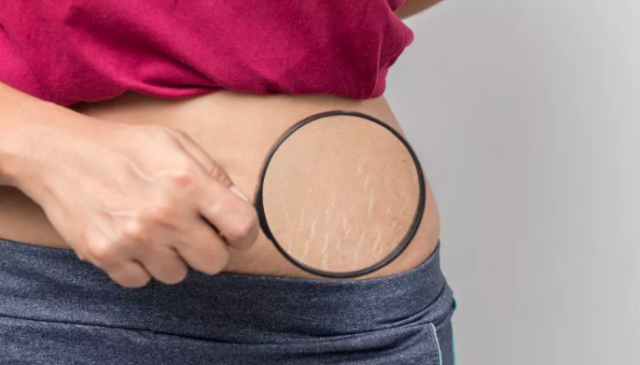How to remove stretch marks on the body at home and in the salon

Stretch marks (striae) are scars on the skin in the form of stripes of various widths and lengths, painted in colors from white to bright red or blue. Most often, stretch marks appear on the abdomen, buttocks, thighs, back, and chest.
Why do stretch marks appear?
Reasons for the appearance of stretch marks:
- Disruption of hormonal levels or changes in them as a result of pregnancy or taking hormonal drugs;
- Sudden weight gain or loss;
- Gaining muscle mass during active strength training
- Puberty in adolescents.
Is it possible to get rid of stretch marks completely
Stretch marks can be both subtle and very deep, affecting most of the body. You can fight the first ones on your own at home, but deep stretch marks can only be eliminated surgically.
Ways to deal with stretch marks
Ways to deal with stretch marks at home
Home methods will be effective only in the fight against the so-called fresh stretch marks and only in combination, which includes:
- Self – massage – it is recommended to do it with creams based on mummy or hyaluronic acid, as well as with retinoid-based ointments. In the fight against stretch marks, natural oils will also be useful: olive, coconut, almond, cocoa and shea butter. The massage is performed in a circular motion, pinching and patting.
- Scrub is an effective remedy against stretch marks. It is best to make your own scrub using coffee, sugar or salt. Scrubbing against stretch marks can be done 3-4 times a week, after the procedure, do not forget to soften the skin with a nourishing cream.
- Wraps – increase the elasticity and firmness of the skin. Clay and oil wraps are very effective. The clay can be purchased at the pharmacy, diluted according to the instructions, and add orange oil. It is recommended to apply the resulting mixture to problem areas, massage and wrap with cling film – for at least an hour.
- Contrast shower – directing a stream of water to problem areas, make circular movements clockwise. The procedure should last from 5 to 10 minutes in each problem area.
- Proper nutrition – Add more fresh vegetables and herbs to your diet, as well as protein.
- A healthy lifestyle – do not forget about sports, walks in the fresh air and the daily routine.
Cosmetic treatments for stretch marks
Laser therapy – during laser resurfacing, the upper layer of the epidermis and partially the deeper layers of the skin are removed. As a result of this procedure, stretch marks are gradually smoothed out, becoming more invisible due to the production of collagen and improvement of skin elasticity.
Chemical peeling – a product containing a concentrated acid is applied to the skin. Peeling, like a laser, dissolves some of the scar tissue and stimulates the growth of healthy skin.
Microcurrents – low-frequency impulses of microcurrents activate metabolic and regenerative processes at the cellular level.
Microdermabrasion – mechanical resurfacing of the damaged area of the skin with a special device with a rotating circular nozzle. The effect is approximately the same as that of laser therapy and chemical peels.
Mesotherapy – vitamin complexes saturated with useful elements, hyaluronic acid, peptides and other drugs that stimulate the synthesis of new collagen fibers are injected under the skin. Mesotherapy has the greatest effect when combined with laser techniques.
Surgical ways to remove stretch marks
Surgery to remove stretch marks is a radical method recommended in exceptional cases when cosmetology and hardware techniques cannot cope with this problem.
The surgical method of removing stretch marks is performed only on the abdomen and is called abdominoplasty – it is performed under general anesthesia and involves a long rehabilitation period.
Prevention of stretch marks
Preventing stretch marks is the most effective way to prevent stretch marks. Skin care should consist of a complex of procedures that will keep the epidermis in good shape. All these measures are aimed at moisturizing and nourishing the skin, as well as increasing blood circulation and elasticity:
- Nourishing and moisturizing the skin with creams, natural oils, lotions;
- Massages and wraps;
- Proper nutrition;
- Sport.